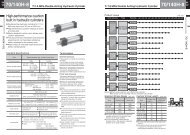70/140H-8 Series (2310KB) - TAIYO
70/140H-8 Series (2310KB) - TAIYO
70/140H-8 Series (2310KB) - TAIYO
Create successful ePaper yourself
Turn your PDF publications into a flip-book with our unique Google optimized e-Paper software.
39<br />
Precautions for use<br />
Precautions<br />
for use<br />
8. Maintenance (maintenance and inspection)<br />
To use cylinders without an accident for a long time,<br />
daily and regular inspections are required.<br />
1) Daily inspection<br />
For the daily inspection, check the points described<br />
below.<br />
(1) Check that the cylinder set bolts and nuts are not<br />
loosened.<br />
(2) Check that the working conditions are normal.<br />
(3) Check that there is no external leakage.<br />
(4) Check that there is no abnormality in other parts of<br />
the cylinder (tie rod , flange, etc.)<br />
2) Regular inspection (disassembly inspection)<br />
Decide the interval of the regular inspection depending<br />
on the working conditions and requirement, and<br />
perform according to the decided schedule. It is recommended<br />
to perform it once a year.<br />
● Replace packings and gaskets with fresh ones at<br />
regular inspections.<br />
● Do not use packings which have been stored for two<br />
years or more.<br />
● Notes on fitting of valve seals<br />
Valve seals must be fit in the specified direction and<br />
sequence. Wrong fitting direction and sequence will<br />
lead to the damaged packings, causing oil leak.<br />
Fitting sequences<br />
➀ Check the direction of a valve seal.<br />
The marked side must be faced inside (refer to Fig.1).<br />
➁ Fit the valve seal to the shaft of the cushion valve<br />
and the shaft of the check plug in the correct fitting<br />
direction (refer to Fig.2).<br />
➂ Take care to prevent the valve seal from being<br />
dropped, and screw it in (refer to Fig.3).<br />
Fig.1<br />
(Identification mark)<br />
Hydrogenated nitrile rubber = orange<br />
Fluoric rubber = white<br />
Fit with the marked side facing inside of the cylinder.<br />
Fig.2 Fig.3<br />
Check plug<br />
Cushion valve<br />
Valve seal<br />
Mark<br />
Mark<br />
(Valve seal fitting sequence)<br />
Prior to the use of cylinders, be sure to read<br />
carefully the precautions below.<br />
Mark side<br />
Mark side<br />
Note If the seal is first fit in the cover hole, and then, it is screwed in, it may<br />
be damaged.<br />
9. Storage<br />
1) Notes on storage<br />
When storing cylinders, take countermeasures against<br />
the followings:<br />
(1) Rusts<br />
(2) Permanent warp and inferiority of packings<br />
2) Storage location<br />
(1) Store cylinders in cool and dark place (max.<br />
temperature: 37°C), and protect them from direct<br />
sunlight and humidity. Place them higher than<br />
30 cm from the floor.<br />
(2) DO NOT apply vibrations or shocks to the stored<br />
cylinders. The cylinder parts may be damaged.<br />
3) Control and inspection during storage<br />
(1) Pack working oil (including rust preventive oil) in<br />
cylinders, and plug the port part.<br />
● If the port part is unplugged during storage, change<br />
working oil with fresh one, and plug again. Failure<br />
to perform this step may cause rusts on tube<br />
inside.<br />
(2) It is recommended to turn the stored cylinder 90°C<br />
every three months to let packed oil flow and<br />
reduce permanent warp of packings.<br />
● If there is any abnormality in the working condition<br />
of the cylinder that has been stored for a long time,<br />
replace packings.<br />
● If the storage period is a year or longer, it is<br />
recommended to perform the internal inspection<br />
of the stored cylinder.<br />
(3) Repeat of rust preventive treatment<br />
After the purchase of cylinders, repeat rust preventive<br />
treatment every year.<br />
● Internal rust-proof measures (rust-proof measures for<br />
cylinder inside)<br />
Change working oil (including rust preventive oil) in<br />
the cylinder.<br />
● External rust-proof measures (for machined face,<br />
exposed part)<br />
Apply rust preventive oil to mounting faces to machines<br />
and machined faces, such as a rod end screw part.<br />
Also, apply grease to the rod slipping part and the dust<br />
seal part, and protect with oil paper.<br />
10. Disposal<br />
1) Disassemble cylinders, sort the disassembled components<br />
by material (iron, copper, aluminum, resin,<br />
rubber, waste oil, etc.) , and then, dispose them.<br />
2) Piston rods are hard chrome plated. When disposing<br />
them, consult with a disposal company.<br />
3) Dispose resin base and rubber base components<br />
as nonflammable wastes.<br />
4) When disposing waste oil, conform to related laws<br />
and rules.




